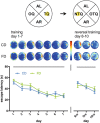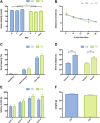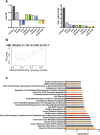High-dose maternal folic acid supplementation before conception impairs reversal learning in offspring mice
- PMID: 28596566
- PMCID: PMC5465191
- DOI: 10.1038/s41598-017-03158-1
High-dose maternal folic acid supplementation before conception impairs reversal learning in offspring mice
Abstract
Maternal folic acid (FA) supplementation prior to and during gestation is recommended for the prevention of neural tube closure defects in the developing embryo. Prior studies, however, suggested that excessive FA supplementation during gestation can be associated with toxic effects on the developing organism. Here, we address whether maternal dietary folic acid supplementation at 40 mg/kg chow (FD), restricted to a period prior to conception, affects neurobehavioural development in the offspring generation. Detailed behavioural analyses showed reversal learning impairments in the Morris water maze in offspring derived from dams exposed to FD prior to conceiving. Furthermore, offspring of FD dams showed minor and transient gene expression differences relative to controls. Our data suggest that temporary exposure of female germ cells to FD is sufficient to cause impaired cognitive flexibility in the subsequent generation.
Conflict of interest statement
The authors declare that they have no competing interests.
Figures






Similar articles
-
Gestational folic acid supplementation does not affects the maternal behavior and the early development of rats submitted to neonatal hypoxia-ischemia but the high supplementation impairs the dam's memory and the Na+, K+ - ATPase activity in the pup's hippocampus.Int J Dev Neurosci. 2018 Dec;71:181-192. doi: 10.1016/j.ijdevneu.2018.10.001. Epub 2018 Oct 11. Int J Dev Neurosci. 2018. PMID: 30315904
-
Intergenerational impact of paternal lifetime exposures to both folic acid deficiency and supplementation on reproductive outcomes and imprinted gene methylation.Mol Hum Reprod. 2017 Jul 1;23(7):461-477. doi: 10.1093/molehr/gax029. Mol Hum Reprod. 2017. PMID: 28535307 Free PMC article.
-
Maternal Exposure of Rats to Isoflurane during Late Pregnancy Impairs Spatial Learning and Memory in the Offspring by Up-Regulating the Expression of Histone Deacetylase 2.PLoS One. 2016 Aug 18;11(8):e0160826. doi: 10.1371/journal.pone.0160826. eCollection 2016. PLoS One. 2016. PMID: 27536989 Free PMC article.
-
High dose folic acid supplementation in women with epilepsy: are we sure it is safe?Seizure. 2015 Apr;27:51-3. doi: 10.1016/j.seizure.2015.02.030. Epub 2015 Mar 7. Seizure. 2015. PMID: 25891927 Review.
-
Folic acid supplementation in pregnancy: Are there devils in the detail?Br J Nutr. 2012 Dec 14;108(11):1924-30. doi: 10.1017/S0007114512003765. Epub 2012 Oct 9. Br J Nutr. 2012. PMID: 23046900 Review.
Cited by
-
Novel genes associated with folic acid-mediated metabolism in mouse: A bioinformatics study.PLoS One. 2020 Sep 11;15(9):e0238940. doi: 10.1371/journal.pone.0238940. eCollection 2020. PLoS One. 2020. PMID: 32915913 Free PMC article.
-
Moderate Folic Acid Supplementation in Pregnant Mice Results in Behavioral Alterations in Offspring with Sex-Specific Changes in Methyl Metabolism.Nutrients. 2020 Jun 8;12(6):1716. doi: 10.3390/nu12061716. Nutrients. 2020. PMID: 32521649 Free PMC article.
-
Spatial Transcriptomics and Single-Nucleus Multi-Omics Analysis Revealing the Impact of High Maternal Folic Acid Supplementation on Offspring Brain Development.Nutrients. 2024 Nov 7;16(22):3820. doi: 10.3390/nu16223820. Nutrients. 2024. PMID: 39599606 Free PMC article.
-
Effect of folic acid diet on the behavior of female mice and ultrasonic vocalization of their F1 offspring.IBRO Neurosci Rep. 2025 Mar 28;18:520-527. doi: 10.1016/j.ibneur.2025.03.007. eCollection 2025 Jun. IBRO Neurosci Rep. 2025. PMID: 40236763 Free PMC article.
-
Excess Folic Acid Supplementation Before and During Pregnancy and Lactation Activates Fos Gene Expression and Alters Behaviors in Male Mouse Offspring.Front Neurosci. 2019 Apr 5;13:313. doi: 10.3389/fnins.2019.00313. eCollection 2019. Front Neurosci. 2019. PMID: 31024236 Free PMC article.
References
-
- MRC. Prevention of neural tube defects: results of the Medical Research Council Vitamin Study. MRC Vitamin Study Research Group. Lancet338, 131–137 (1991). - PubMed
Publication types
MeSH terms
Substances
LinkOut - more resources
Full Text Sources
Other Literature Sources
Medical
Molecular Biology Databases

